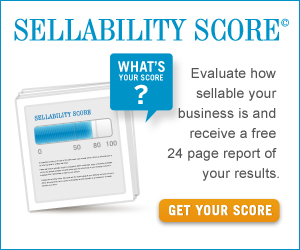Republished with permission from Built to Sell Inc.
 Prevention is better than cure
Prevention is better than cure
To grow a valuable business – one you can sell – you need to set up your company so that it is no longer reliant on you. Financial Planning for business owners is less about what you can take out of your business and more about what you can do to it so that it runs without you.
This can be easier said than done, especially when, like a PR consultant or plumber, what you are selling is your expertise.
To scale up a knowledge-based business, you first have to figure out how to impart your knowledge to your employees, so that they can deliver the goods. However it can be difficult to condense years of school and on-the-job learning into a few weeks of employee training. The more specialised your knowledge, the harder it is to hand over work to juniors.
The key to scaling up a service business can often be found by offering the service that prevents customers from having to call you in the first place. You have to shift from selling the cure to selling the prevention.
Fixing what is broken is typically a hard task to teach; however, preventing things from breaking in the first place can be a far easier task to train others to do.
For example, it takes years for a dentist to acquire the education and experience to successfully complete a root canal, but it’s relatively easy to train a hygienist to perform a regularly scheduled cleaning.
It’s almost effortless for an estate agency manager to hire someone to clean the gutters once a month, but repairing the flooded basement caused by the clogged gutters can be quite complex.
For a master car mechanic, overhauling an engine that has seized up takes years of training, but preventing the problem by regularly changing a customer’s oil is something a high school student can be taught to do.
For an IT services company, restoring a customer’s network after a virus has invaded often takes the know-how of the boss, but preventing the virus by installing and monitoring the latest software patches is something a junior can easily be trained to do.
When you’re selling your expertise, it can be tough to hire a team to do the work for you. As ironic as it sounds, sometimes the key to getting out of doing the work is to offer a preventive service, which not only maintains your business income, but also eliminates the need for someone to call you in the first place.
Financial planning for business owners is different. Following the same traditional financial planning methods appropriate for your employees will lead you down the wrong path. Your business is where your wealth is and planning how to access that wealth when it comes time to retire is key.
Wondering if you have a sellable business? The Sellability Score is a quantitative tool designed to analyze how sellable your business is. After completing the questionnaire, you will immediately receive a Sellability Score out of 100 along with instructions for interpreting your results.
Take the Quiz here: The Business Sellability Audit
Why not find out now if your business is sellable?
This free online tool is the only no-risk step you can take to determine if your business is ready to get full value. Fast-track your analysis by taking advantage of this free, no-obligation free online tool.
This Sellability Score you instantly receive is a critical component to any business owner’s complete financial plan and is something that, until now, we have only made available to existing clients.
However, we recognized that there is value in knowing in advance of working with a financial planner whether or not your largest asset is ready to be exchanged for your retirement nest egg. Our view is that you are better to learn more about your businesses sellability today and find out how your business scores on the eight key attributes so that you can ensure you obtain full value.
If your business part of your retirement plan, finding out your sellability score will be the best 10 min. you could ever spend working “on” your business.
 For more free information on Creating A Business Owner’s Dream Financial Plan, you can listen to a free, eight part series we did exclusively for business owners. The show is also available to subscribe to for free via iTunes.
For more free information on Creating A Business Owner’s Dream Financial Plan, you can listen to a free, eight part series we did exclusively for business owners. The show is also available to subscribe to for free via iTunes.




 Warren Buffett famously invests in businesses that have what he calls a protective “moat” around them – one that inoculates them from competition and allows them to control their pricing.
Warren Buffett famously invests in businesses that have what he calls a protective “moat” around them – one that inoculates them from competition and allows them to control their pricing.






